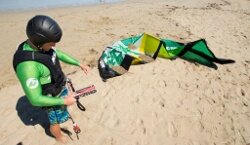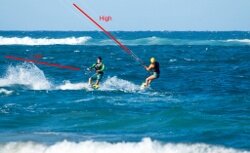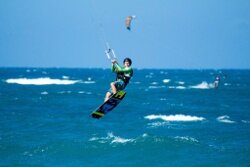Try the new IKO website at https://beta.ikointl.com/

Kite Tips of December
02 Jan 2017
|
Right of Way - The Golden Rule
There are many Right of Way rules that kiters need to be aware of. The most important one is the Golden Rule! When two riders are kiting in the opposite direction, the one going upwind must keep the kite high and the one going downwind must keep the kite low. Being aware of this simple rule will allow you to kite in a crowded spot without tangling your lines with others. Many beginners are not aware of the Golden Rule and tend to bring their kite up every time they approach another kiter who, as a result, will have to bring his kite up too and stop. Learn all the Right of Way rules with an IKO Instructor to make the sport more enjoyable and safe for all!
|
 |
|
Jump safety
Are you ready to attempt your first jumps? What an exciting moment in every kiter’s life that is going to become 3 Dimensional! However make sure to respect the following basics to ensure your safety! Do not try your first jump on gusty winds or strong winds. Light steady wind is the one you are looking for! Always wear a helmet and an impact vest to avoid injuries. Remember to keep a clear zone of at least 30m upwind and 50m downwind. Never forget that when you jump you lose the right of way. A piece of advice, focus on the board’s pop without any kite movement at first, it is the key to jump very high later using the kite. To improve your jump technique faster, find an IKO Coach!
|
 |
|
Riding on a wave
Tired of flat water twin-tip riding? Challenge yourself and diversify your practice riding the waves! You can use your twin-tip for the first discovery attempts however it is recommended to switch for a directional board, keeping the straps for aggressive riding, or removing them for smooth or freestyle riding! You will be more in contact with the element. Be sure to know the tides, currents and that the waves are not too big for you! Never use a board leash as it is very dangerous and remember that the rider riding a wave has the priority over the others. To improve faster, you can attend an Evolution Course or Clinic with a certified IKO Coach!
|
 |
|
You wanna start kiteboarding, here are some beginner tips
Ready to finally jump off the plane and start kiteboarding? If not well organized, a first kite experience can be frustrating… You will need 3 to 5 days of practice to become an independent rider. This means 3 to 5 days of wind... So first of all, select the spot where you want to learn and check on several sources what the best time of the year is in terms of wind probability. Schedule a stay of at least 2 weeks so you have more chances to hit these windy days. After this, check out the IKO online videos to prepare your training. Get fit before the beginning of your course, this will help you have longer sessions as the time of practice is the key to ensure your progression. Then go for it and learn together with a certified IKO Instructor!
|
 |
|
How to buy used kite gear
Now that your first course is done, you may want to buy your first kite equipment! You still might crash your kite from time to time and possibly break it. For this reason buying a second-hand gear is a good alternative as it will have fewer financial consequences. Before buying a second-hand kite, be sure to physically see it. First thing first, pump it up and control it stays inflated. While inflated check out for repairs, or small tears. Watch closer the leading edge, valves and especially the trailing edge. You must also control the lines and the general state of the fabrics all over the bar. Look for small knots that would weaken the lines. For boards, check if you see any holes due to impacts. Watch the fabric state of the straps and pads. Ask for the year of the equipment and compare the prices on the market to be able to negotiate it. If you are not experienced, the help of a more advanced kiter is always welcome!
|
 |
.png)

